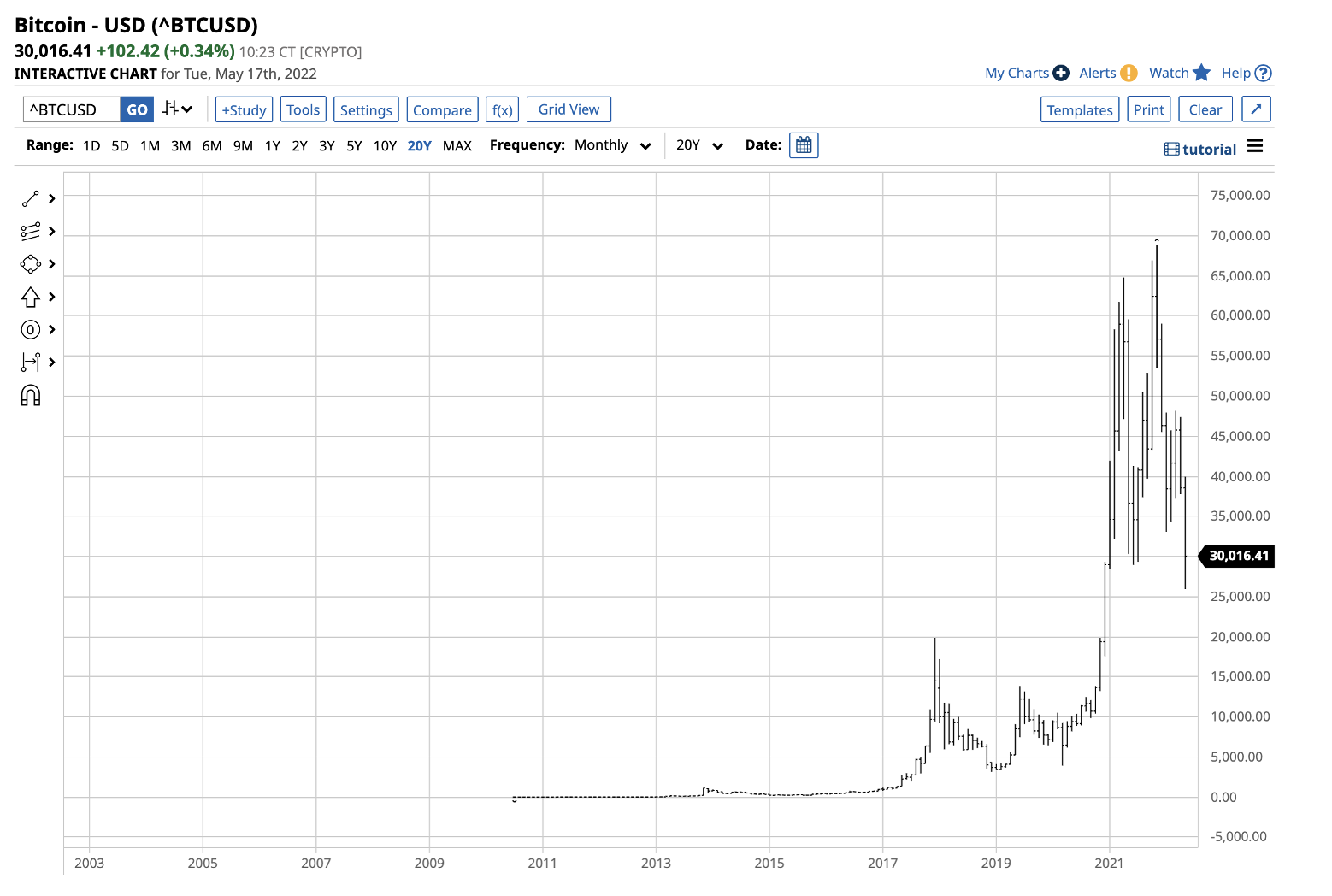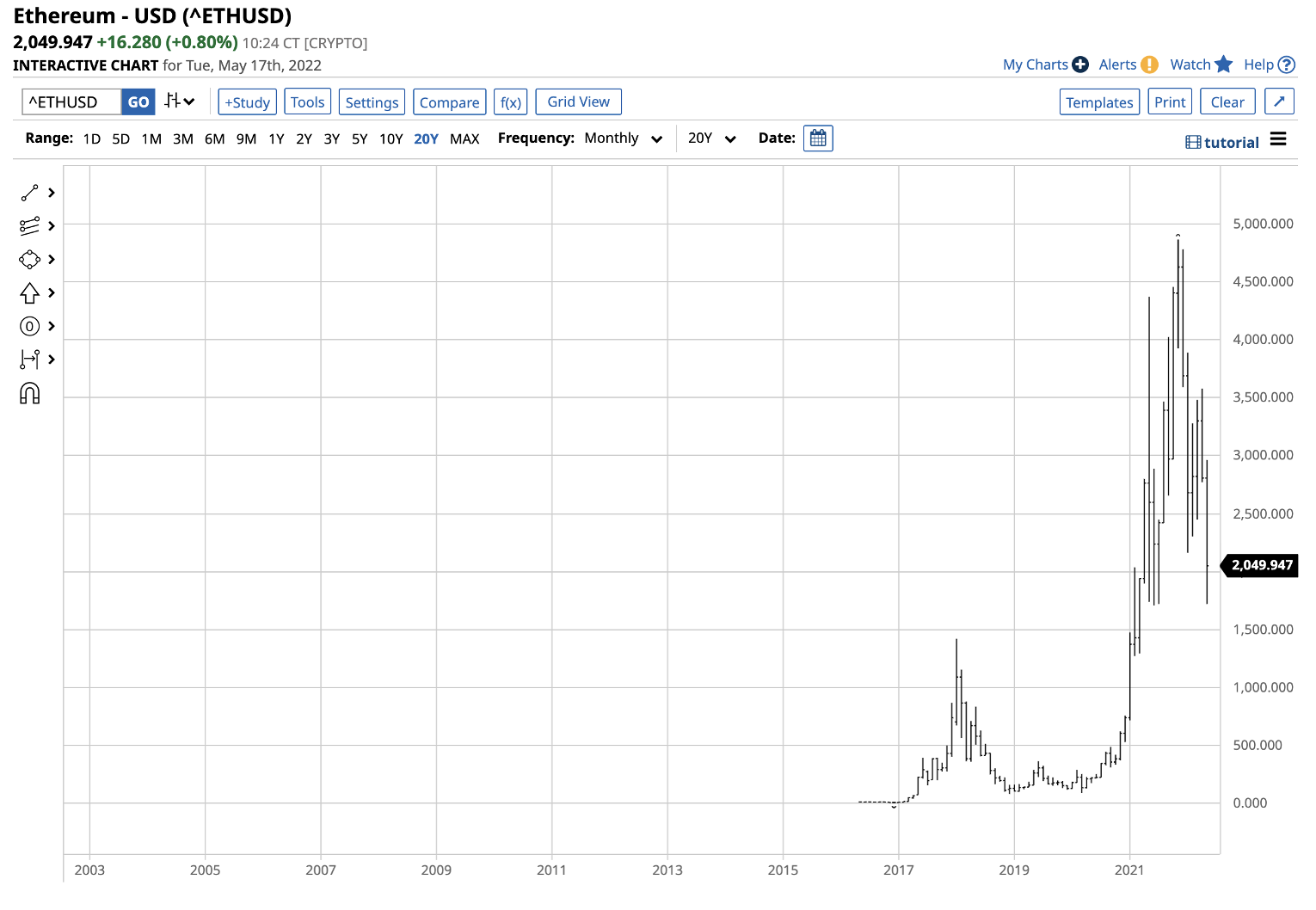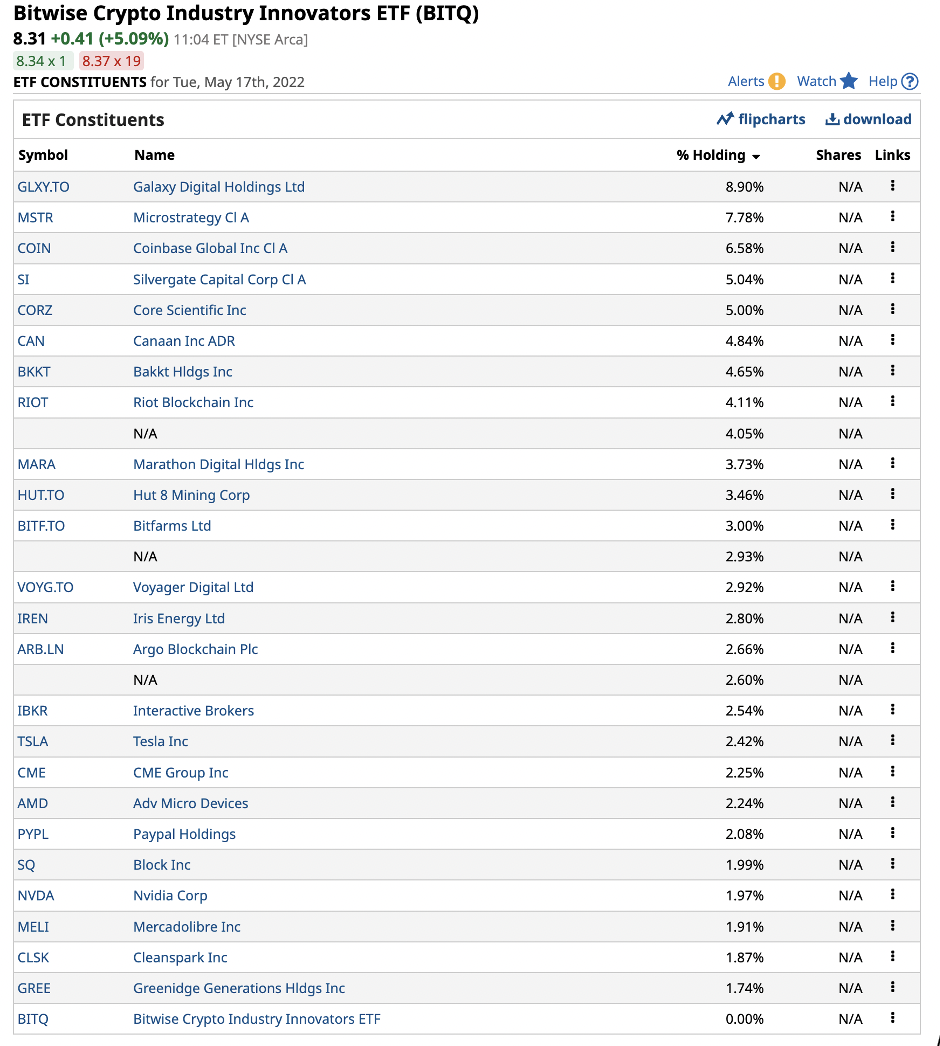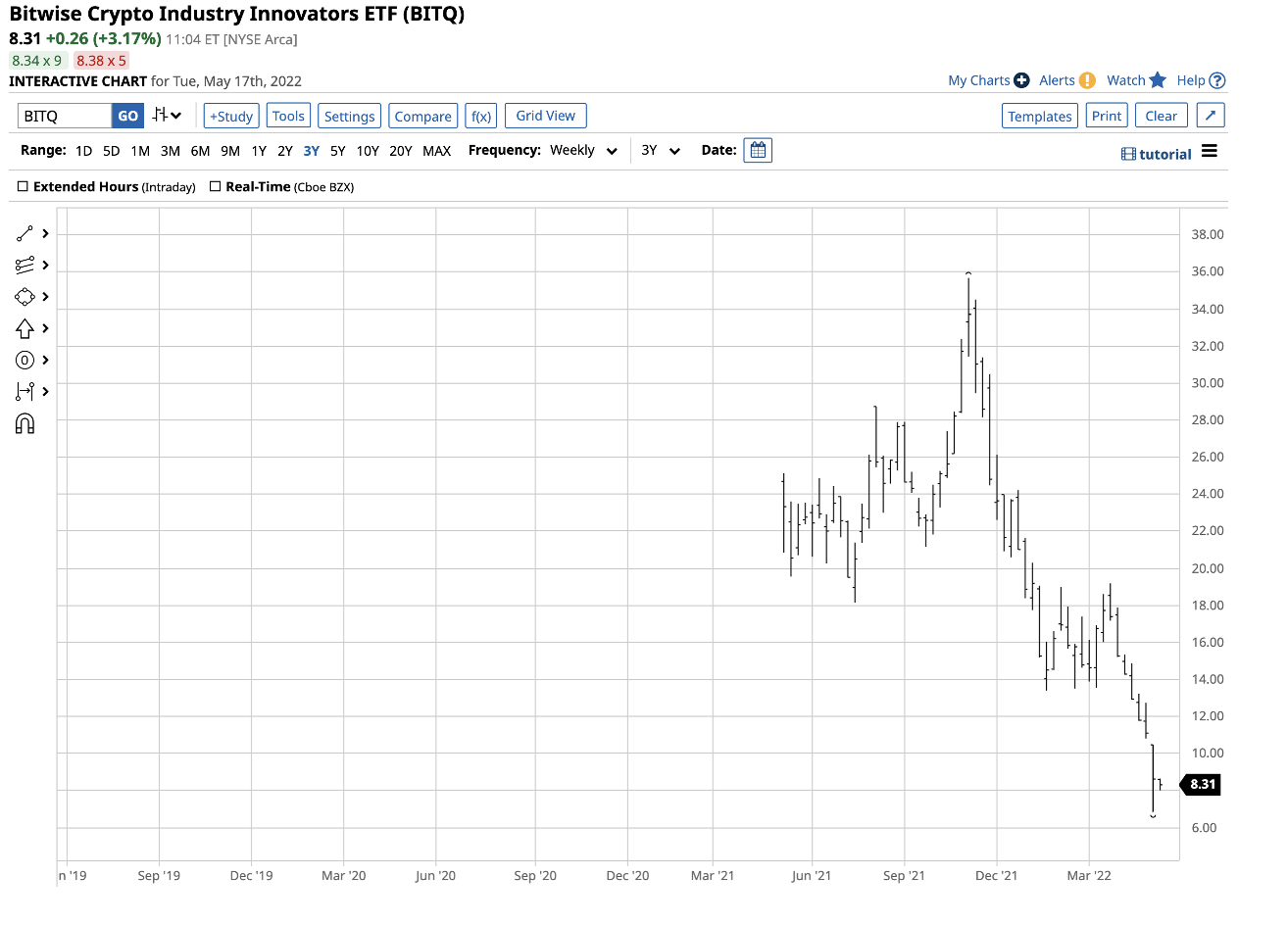This article was written exclusively for Investing.com
- Bitcoin and Ethereum price action reduces speculative froth
- Cryptos have not embraced inflation
- Are they warning about recession or stagflation?
- 3 reasons why they should make a significant comeback
- For tools, data, and content to help you make better investing decisions, try InvestingPro
So much is going on in markets these days to confuse and worry traders, investors, and other market participants. Stocks have been trending lower, while the bond market has tanked to the lowest level in nearly eight years. Risk has risen to levels not seen since early 2020, when the global pandemic gripped markets. However, May 2022 is different from March 2020, when the world faced a virus, a common enemy.
The war raging in Ukraine has only exacerbated economic issues facing the world. With many market participants hunkering down and cutting back on risky assets, speculating on cryptocurrencies is the last thing on their minds. The speculative frenzy in the crypto arena fizzled out after the Nov. 10 record high. In late January, Bitcoin, Ethereum and many other cryptos fell to lows. They continue to consolidate much closer to the lows than the late 2021 highs.
With the market’s attention on the war, inflation, the potential for a recession, supply-chain issues, Chinese lockdowns, tensions between nuclear powers, and many other issues, this could be the perfect time to consider adding crypto exposure to portfolios. For those looking for a proxy to the tokens, the Bitwise Crypto Industry Innovators ETF (NYSE:BITQ) is a liquid product that follows the prices higher and lower. The BITQ ETF is a pick-and-shovel play on the asset class.
Price Action With Bitcoin, Ethereum Reduces Speculative Froth
On the way up, a speculative frenzy possessed the cryptocurrency markets as Bitcoin and Ethereum were poster children for creating incredible wealth.

Source: Barchart
On the way up, Bitcoin attracted buyers as tales of turning a $100 investment in 2010 into millions fostered a speculative stampede.

Source: Barchart
Ethereum, the crypto with the second-leading market cap, experienced the same buying frenzy when the price was moving higher.
On the downside, the attraction evaporated as the price action caused losses and brought the buying to a halt.
Cryptos Have Not Embraced Inflation
Some market participants and crypto devotees had hoped that rising inflation that erodes fiat currency purchasing power would support cryptocurrencies. The theory is that governments, central banks, and monetary authorities can increase the money supply to their heart’s content. The only way to increase the crypto supply is via mining.
The theory has not turned into practice as the highest inflation levels in over four decades have not supported crypto values. The US CPI and PPI data have done nothing to support Bitcoin, Ethereum, and most of the other more than 19,470 cryptocurrencies. Moreover, rising interest rates have pushed the US dollar index to the highest level since 2002 against other fiat currencies. Inflationary pressures causing higher US dollar yields have weighed on crypto values.
Are They Warning About Recession Or Stagflation?
While US and global inflation is raging, US GDP declined by 1.4% in the first quarter of 2022. COVID-19 lockdowns in China weigh on the world’s second-leading economy. A recession is two-quarters of declining GDP, and the economy faces the same issues in Q2. A recession with a continuation of inflationary pressure is stagflation, which is a challenge for the Federal Reserve and other central banks around the world that use monetary policy to achieve maximum employment and economic stability.
Moreover, the war in Ukraine and tensions between China/Russia and the US/Europe have caused supply-side issues, distorting raw material supplies and business activity. Monetary policy can be highly effective when dealing with demand-side macroeconomic problems, but the central banks have few tools to deal with the supply side.
The decline in cryptocurrencies, which have made lower highs and lower lows since November 2021, is a warning that economic conditions are deteriorating, and central banks and governments have become bystanders and deer in the bright economic and geopolitical headlights.
3 Reasons Why They Should Make A Significant Comeback
During bull and bear markets, prices tend to rise and fall to illogical, unreasonable, and irrational levels. In 2020, NYMEX crude oil fell below zero when the demand evaporated. Two years later, the price was north of $110 per barrel.
Cryptocurrency volatility only exacerbates the price variance. I believe three factors will eventually lead to bottoms and recoveries:
- Ideologically, cryptos embrace libertarianism that rejects government control. As the faith and credit of governments decline, cryptos will likely play a more significant role in the global economy.
- The current hawkish monetary policy path is making room for the next crisis, which will lead to another round of liquidity and stimulus, further weighing on fiat currency values. The war in Europe, tensions on the geopolitical landscape, and all the fallout from supply-side economic distortions are not bearish for alternative means of exchange that have already taken steps to become more mainstream assets.
- Cryptocurrencies reflect the evolution of the fintech revolution, improving the speed, efficiency, and record-keeping of financial transactions. Ubiquitous acceptance of blockchain technology includes the cryptocurrencies that are fintech’s chicken or egg to the blockchain.
When cryptos reach the bottom and turn higher, expect a buying stampede as the speculative frenzy returns to the asset class.
BITQ ETF Is Bitcoin Soup
Asset classes experience cycles, and cryptocurrencies are stuck in a bearish period. It is virtually impossible to pick tops or bottoms in any asset class, and cryptos are uniquely challenging because of their high price variance.
Many market participants have not dipped a toe into the crypto arena because computer wallets that hold the cryptocurrencies are uniquely different from traditional investment custody platforms. Exchanges holding cryptos face other challenges. Last week, Coinbase (NASDAQ:COIN) warned that bankruptcy could wipe out user funds, or cryptos held for customers, as they would become “general unsecured creditors.” In bankruptcy, they would have no right to claim any specific property from the exchange in proceedings, and their funds (or cryptos) would become inaccessible. There is no FDIC insurance for crypto exchange deposits protecting customers. The warning further weighed on crypto values as they added a new level of risk for the asset class.
Meanwhile, the burgeoning asset class faces many roadblocks, and exchange bankruptcy is another hurdle. Coinbase and other exchanges will need to address these issues over the coming weeks and months. The future viability depends on a successful resolution, providing customers with confidence. I believe cryptos and the leading exchange will survive and thrive when the crypto cycle shifts from bear to bull.
The Bitwise Crypto Industry Innovators ETF product is a pick-and-shovel play on the asset class as it holds shares of exchanges, miners, and other cryptocurrency-related companies. The holdings include:

Source: Barchart
At the $8.31-per-share level on May 17, BITQ had $59.443 million in assets under management and trades an average of 141,014 shares each day. BITQ charges a 0.85% management fee.
BITQ is a volatile ETF product that rises and falls with the cryptocurrency asset class.

Source: Barchart
BITQ reached a high of $35.68 per share in November 2021, when Bitcoin and Ethereum reached record peaks. At the $8.31 level on May 17, I view the ETF as an inexpensive call option on the cryptocurrency asset class with no expiration date. BITQ can go to zero, but it can also soar if cryptocurrencies find bottoms and the cyclical trend turns bullish.
Only invest capital you are willing to lose in any crypto-related asset. Risk is always a function of potential rewards. At the $8.31 per share level, BITQ’s risk justifies the potential for rewards.
In May 2022, cryptocurrencies have become a forgotten asset class, but that will likely change when they find bottoms and a speculative stampede of returns.
The current market makes it harder than ever to make the right decisions. Think about the challenges:
- Inflation
- Geopolitical turmoil
- Disruptive technologies
- Interest rate hikes
To handle them, you need good data, effective tools to sort through the data, and insights into what it all means. You need to take emotion out of investing and focus on the fundamentals.
For that, there’s InvestingPro+, with all the professional data and tools you need to make better investing decisions. Learn More »
